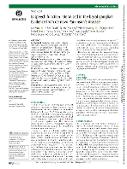Is speech function lateralised in the basal ganglia? Evidence from de novo Parkinson's disease

Author
Tykalova, Tereza
Novotny, Michal
Illner, Vojtech
Simek, Michal
Kouba, Tomas
Kryze, Petr
Sousa, Mario
Jorge, Adriana
Nef, Tobias
Krack, Paul
Publication date
2025Published in
Journal of Neurology, Neurosurgery and PsychiatryVolume / Issue
96 (5)ISBN / ISSN
ISSN: 0022-3050ISBN / ISSN
eISSN: 1468-330XMetadata
Show full item recordCollections
This publication has a published version with DOI 10.1136/jnnp-2024-334297
Abstract
Background: Research on the possible influence of lateralised basal ganglia dysfunction on speech in Parkinson's disease is scarce. This study aimed to compare speech in de-novo, drug-naive patients with Parkinson's disease (PD) with asymmetric nigral dopaminergic dysfunction, predominantly in either the right or left hemisphere. Methods: Acoustic analyses of reading passages were performed. Asymmetry of nigral dysfunction was defined using dopamine transporter-single-photon emission CT (DAT-SPECT). Results: From a total of 135 de novo patients with PD assessed, 47 patients had a lower right and 36 lower left DAT availability in putamen based on DAT-SPECT. Patients with PD with lower left DAT availability had higher dysarthria severity via composite dysarthria index compared with patients with lower right DAT availability (p=0.01). Conclusion: Our data support the crucial role of DAT availability in the left putamen in speech. This finding might provide important clues for managing speech following deep brain stimulation.
Keywords
speech, parkinson's disease, motor control, movement disorders
Permanent link
https://hdl.handle.net/20.500.14178/2692License
Full text of this result is licensed under: Creative Commons Uveďte původ 4.0 International







